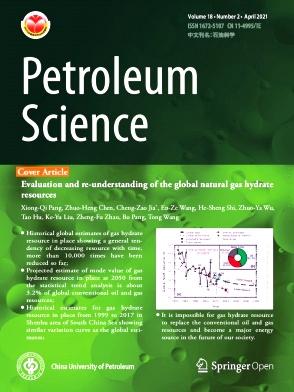俄罗斯伏尔加-乌拉尔石油省Domanik (Semiluksk)层位沉积物地球化学特征及形成条件
IF 6
1区 工程技术
Q2 ENERGY & FUELS
引用次数: 0
摘要
利用地球化学研究重建了上泥盆统Domanik沉积条件。研究对象Domanik沉积物正在俄罗斯伏尔加-乌拉尔石油省进行开发。从南鞑靼拱门和比尔斯卡亚鞍区共四口井采集了岩心样本。宏观描述、光学显微岩相检查、x射线分析、x射线荧光分析、电感耦合等离子体质谱(ICP-MS)、同步热分析、扫描电子显微镜(SEM)、岩石热解研究和相关性分析是研究中使用的方法。碳酸盐岩、富有机质碳酸硅质岩和碳酸盐岩角砾岩是已识别的主要岩性类型。富有机质碳酸盐-硅质岩的主要造岩矿物为自生石英(玉髓)。有机质浓度与石英之间缺乏相关性,同时进行的热研究和扫描电镜结果表明,石英以生物和化学两种形式存在。利用Cd/Mo和Co × Mn指标证明了Domanik沉积物海的可变水动力条件:沉积物在静止和季节性上升流条件下沉积。多马尼克海的主要生物生产力也受到热液活动的影响。代理(Fe + Mn)/Ti数据和用Zn-Ni-Co三角图评价岩石成因的结果证实了这一点。热液流体的存在不仅提高了古盆地的初级产量,而且还提供了二氧化硅,碳酸盐-硅质岩石中二氧化硅与呼出组分之间的密切关系证明了这一点。火山活动对Domanik沉积物的成因影响较小。通过U/Th-TOC和V/Cr-TOC的代用数据,以及U- ef和Mo-EF在共变图上的表现,揭示了Domanik海的缺氧和缺氧状态,影响了沉积物中有机质的埋藏。同时,陆源摄取量有限。碳酸盐岩角砾岩是多玛尼克沉积剖面中常见的碳酸盐岩角砾岩,其形成可能是由地震驱动的碳酸盐岩碎屑向碳酸硅质物质的重力转移所致。本文章由计算机程序翻译,如有差异,请以英文原文为准。
Geochemistry and formation conditions of the Domanik sediments (Semiluksk horizon) in the Volga-Ural petroleum province, Russia
The study reconstructs the Upper Devonian Domanik sedimentation conditions using geochemical studies. Domanik sediments, the subject of study, are being developed in Russia's Volga-Ural petroleum province. Core samples have been collected from the South Tatar arch and the Birskaya saddle, totaling four wells. Macroscopic description, optical microscopic petrographic examination, X-ray analysis, X-ray fluorescence analysis, inductively coupled plasma mass spectrometry (ICP-MS), simultaneous thermal analyses, scanning electronic microscopy (SEM), Rock-Eval pyrolytic studies, and correlation analysis were among the methods used in the study. Carbonate rocks, carbonate-siliceous rocks enriched with organic matter, and carbonate breccias are the main identified lithotypes. The predominant rock-forming mineral in carbonate-siliceous rocks enriched with organic matter is quartz (chalcedony) of authigenic genesis. The lack of correlation between organic matter concentration and quartz, as well as the results of simultaneous thermal studies and SEM, suggest that quartz is present in both biogenic and chemogenic forms. The proxies Cd/Mo and Co × Mn were used for proving variable hydrodynamic conditions in the Domanik sediments sea: sediments were deposited under both stationary and seasonal upwelling conditions. The major bioproductivity of the Domanik sea was also influenced by hydrothermal activity. The proxy (Fe + Mn)/Ti data and the results of the rock genesis evaluation using the Zn-Ni-Co triangle diagram confirm this. The presence of hydrothermal fluids not only improved primary production in the paleobasin, but it additionally provided silica, as evidenced by the strong relationship between silica and exhalation components in carbonate-siliceous rocks. Volcanic activity had a slight impact on Domanik sediment genesis. Anoxia and euxinia in the Domanik sea were indicated by proxy U/Th-TOC and V/Cr-TOC data, as well as behavior of U-EF and Mo-EF on the covariation plot, which influenced organic matter burial in the sediments. Simultaneously, the terrigenous intake was limited. Carbonate breccias, which are common in the Domanik sediments section, developed as a result of the gravitational transfer of carbonate fragments into the carbonate-siliceous material, which might be driven by earthquakes.
求助全文
通过发布文献求助,成功后即可免费获取论文全文。
去求助
来源期刊

Petroleum Science
地学-地球化学与地球物理
CiteScore
7.70
自引率
16.10%
发文量
311
审稿时长
63 days
期刊介绍:
Petroleum Science is the only English journal in China on petroleum science and technology that is intended for professionals engaged in petroleum science research and technical applications all over the world, as well as the managerial personnel of oil companies. It covers petroleum geology, petroleum geophysics, petroleum engineering, petrochemistry & chemical engineering, petroleum mechanics, and economic management. It aims to introduce the latest results in oil industry research in China, promote cooperation in petroleum science research between China and the rest of the world, and build a bridge for scientific communication between China and the world.
 求助内容:
求助内容: 应助结果提醒方式:
应助结果提醒方式:


